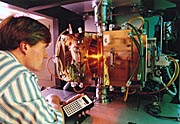About Us
Composition of the Group
The group has four permanent members of staff, Prof. Geetha BalakrishnanLink opens in a new window, Dr Oleg PetrenkoLink opens in a new window, Prof. Paul GoddardLink opens in a new window, and Prof. Martin LeesLink opens in a new window. In addition we currently have 1 EPSRC funded Research Fellow (Dr Dan MayohLink opens in a new window), and 4 PhD and MSc students (30 PhD and 4 MPhil/MSc students have graduated from the Group since 1995). The group was founded in 1984 by Prof. Don McKPaulLink opens in a new window.
How does the Group operate?
The Superconductivity and Magnetism Group has three core activities:
(1) single crystal growth and sample preparation.
(2) measurements of magnetic, thermodynamic and transport properties.
(3) work at central facilities including neutron scattering, muon spectroscopy, and high field studies.
These activities are complementary and have produced a dynamic and fruitful research programme that is continually evolving and moving forward into new areas.
There are a number of ways in which a new research project may get started. An interesting new physical phenomena or effect may have been observed in one or more materials. We learn of these discoveries via our collaborators or by reading new publications and preprints. Alternatively, a member of the Group may have an idea or question about a problem of interest, and after carefully reviewing the well established scientific literature discover that no one has worked on this area before.
|
|
In any event, once a question has been posed the next step is to ask, can I answer the question, or at the very least help to develop a better understanding of the physics of the problem? If the answer is yes, then experimental work can begin. More often than not this means preparing a sample. We will attempt to prepare good quality (usually single crystal) samples of the materials of interest. |
| An NEC infra red image furnace used to grow single crystals here at Warwick |
| Once single crystals have been prepared they can be characterised and their properties studied in the Groups laboratories using a range of simple but powerful experimental techniques. This involves measurements of the magnetic, thermodynamic and transport properties of the samples using a range of cryostats. |  |
| We can access temperatures between 300 mK and 800 K and carry out measurements in magnetic fields up to 17 tesla. | MagLab VSM used at Warwick |
|
|
In parallel with these activities, more time consuming and expensive studies are planned and undertaken at central facilities, both here in the UK and overseas. These may include neutron scattering experiments, muon spectroscopy, x-ray studies or measurements made under high magnetic fields. We also work with collaborators at home and abroad to carry out measurements that are not possible in our own laboratories. |
| The reactor hall of the high flux reactor at the ILL in Grenoble |
The results of all these measurements are analysed and combined to form the basis of publications.
The results can also be used to take the research in new directions. This may mean more measurements of one kind or another, or a new round of sample preparation, characterisation and experimental measurements. This is just one example of the way in which the research of the Group may develop. Sometimes it is the growth of single crystals that comes first, sometimes samples are already available and it is the measurements and their results that are the catalyst for new studies.
Over the years the group has work in a number of areas that are of interest to the Condensed Matter Physics community. In these Research pages we give brief accounts of some of these research programmes.
Some useful links
How to find us in the Physics Department
How to get to Warwick University
Former members of the Superconductivity and Magnetism Group
 |
EPSRC homepage


